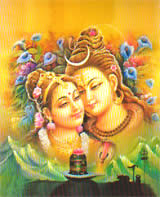|
|
Mahashivaratri
(the great night of Shiva) falls on the fourteenth day of the dark fortnight
of Phalguna(Febuary-March) , and is dedicated to the worship of Lord Shiva
. This festival is purely religious in nature and universally observed
by all Hindus. On this day devotees sing bhajans in honor of Shiva, recite
Sanskrit shlokas (verses) from scriptures, offer prayers in the morning
and evening, and some observe fasting throughtout the day. People visit
nearby temples of Shiva and offer prayers in large crowds. The prayers
and worship continue late into the night when the devotees offer coconut,
Bilva leaves, fruits, and specially prepare sacred food to Shiva and his
divine consort Parvati. Offering Bilva leaves to Shiva on Shivaratri is
considered very auspicious by his devotees.
| The origin of Shivaratri
is attributed to several stories in Hindu mythology. One very popular
story traces the origin of this festival to the churning of the
Ocean of Milk by devas (gods) and asuras (demons). It is said that
when both gods and demons were churning the Ocean of Milk to obtain
amrita (water of immortal life), they came across many unusual substances,
including the deadly poison Kalakuta. As soon as they touched the
poison, it exploded into poisonous fumes that threatened to envelope
the entire universe by darkness. When the destruction of the universe
seemed inevitable, the gods ran for assistance from Brahma and Vishnu,
but neither was able to |
 |
help. At last they ran to Lord Shiva, who raised
his trident and condensed the fumes. In order to save the creation,
Shiva swallowed the poison without spilling a single drop. The poison
left a dark blue mark on Shiva's throat. The gods praised and workshipped
Shiva for saving the universe.
The philosophical essence of the above myth is as follows: gods and demons
symbolize all kinds of individuals (both good and bad) in the world. The
Ocean of Milk represents ideal world that is full of peace and happiness
for all human beings. Churning the Ocean of Milk signifies the human activity
in the world. The amrita symbolizes happiness and the poison represents
human greed and selfishness. Shiva symbolizes the atman (self), the spiritual
essence of an individual. Worship of Shiva denotes meditation and contemplation
by and individual on his or her own self.
The above story is symbolic of the fact that individuals perform actions
in the world in order to achieve happiness in this process a person is
usually overpowered by greed and selfishness, running his or her efforts
for obtaining peace and happiness. Thus the only way to achieve peace
and happiness is by worshipping Shiva at night, that is, by meditating
on one's own self during the night when the individual is free from the
distractions of the physical world. When the individual attains self-knowledge,
he or she can live in the world without being affected by anger, greed,
and selfishness, the three enemies of one's soul. Since Shivaratri symbolizes
the worship of the atman within this festival by all Hindus, as stated
earlier.
Another story in Hindu mythology also emphasizes the auspiciousness of
Shivaratri. On the day of Shivaratri , hunter, who had killed many birds
in a forest, was chased by a hungry lion. The hunter climbed a Bilva tree
to save himself from the lion's attack. The lion waited throughout the
entire night at a bottom of the tree for its prey. In order to stay awake
to avoid falling from the tree, the hunter kept plucking the leaves of
the Bilva tree and dropping them below. The leaves fell on Shiva Linga
that happened to be located at the bottom of the tree. Shiva was pleased
by the offering of the Bilva leaves by the hunter, although inadvertently,
and saved the hunter in spite of all the sin the hunter had committed
by killing the birds. This story emphasizes the auspiciousness of worshipping
Shiva with Bilva leaves on Shivaratri.
©
2001 vandemataram.com All rights reserved
|
 |